|

The European wildcat (Felis silvestris silvestris) inhabits forests of Western, Central and Eastern Europe, as well as in Scotland and Turkey; it is not found in Scandinavia, Iceland, England, Wales, and Ireland. Its physical appearance is much bulkier than that of the desert cats and domestic cats. The thick fur and size are distinguishing traits; a wildcat normally would not be mistaken for a domestic cat. In contrast to domestic cats, they are most active in the daytime.
 Pure? Wildcats were common in the European Pleistocene era; when the ice vanished, they became adapted to a life in dense forests. In most European countries they have become very rare. Although legally protected, they are still shot by hunters taking them for domestic cats. In Scotland, interbreeding with feral cats is also a threat to the wild population. It is not known to what extent the interbreeding has affected or replaced the wild population, and although some have claimed that there are no "pure" wildcats left at all, there is still considerable disagreement. Pure? Wildcats were common in the European Pleistocene era; when the ice vanished, they became adapted to a life in dense forests. In most European countries they have become very rare. Although legally protected, they are still shot by hunters taking them for domestic cats. In Scotland, interbreeding with feral cats is also a threat to the wild population. It is not known to what extent the interbreeding has affected or replaced the wild population, and although some have claimed that there are no "pure" wildcats left at all, there is still considerable disagreement.
Locations and loss of habitat: Two subspecies coexisted in large numbers in the Iberian Peninsula: the common European subspecies, F. s. silvestris, north of the Douro and Ebro rivers, and the giant Iberian subspecies F. s. tartessia, in the rest of the territory. The last is one of the heaviest subspecies of Felis silvestris; In his book Pleistocene Mammals of Europe (1963), palaeontologists Dr. Björn Kurtén noted that this subspecies conserves the same size of the form that lived in all Europe during the Pleistocene. Although Spain and Portugal are the West European countries with the greatest population of wildcats, the animals in these region are threatened by breeding with feral cats and loss of habitat.
Smaller African Desert Cat: The African wildcat or desert cat (Felis silvestris libyca) is distributed over deserts and savannahs of Africa and the Arabian peninsula. It is considerably smaller than the European subspecies and has shorter fur. The African wildcat is believed to be the ancestor of the domestic cat, since it is tamer than the European wildcats and active at night.
Domestic sized wildcat: The Asiatic wildcat, Asian steppe wildcat or Indian desert cat (Felis silvestris ornata) primarily inhabits the Rajasthan desert and in Rann of Kutch in India. It is about the size of a domestic cat with a pale yellowish body marked  with black spots. This is currently an endangered species partly due to poaching for its prized skin. with black spots. This is currently an endangered species partly due to poaching for its prized skin.
Idolizing Cats: Although some authorities claim that domestication of cats took place as early as 8000 BC, the oldest indisputable evidence is Egyptian depictions from about 4000 BC. However, a 2004 discovery in Shillourokambos, Cyprus provides strong evidence of at least the taming, if not domestication, of wildcats circa 7500 BC.
All text is available under the terms
of the GNU Free Documentation License
|